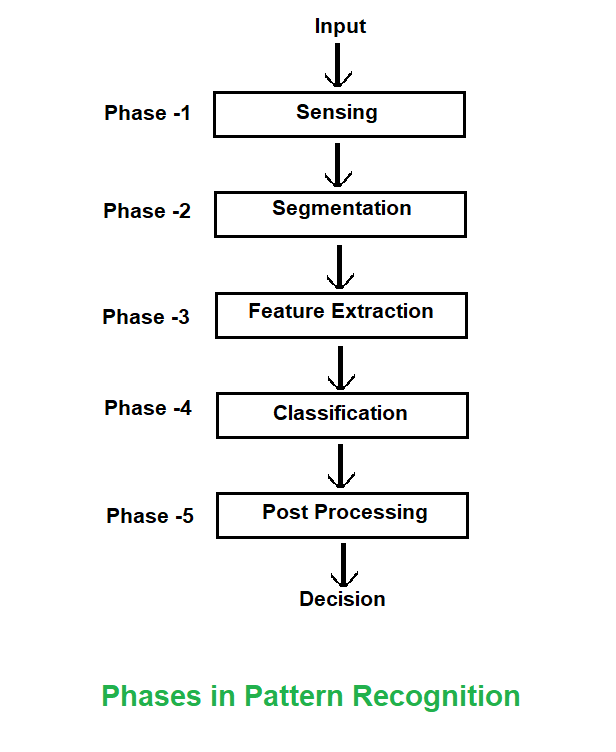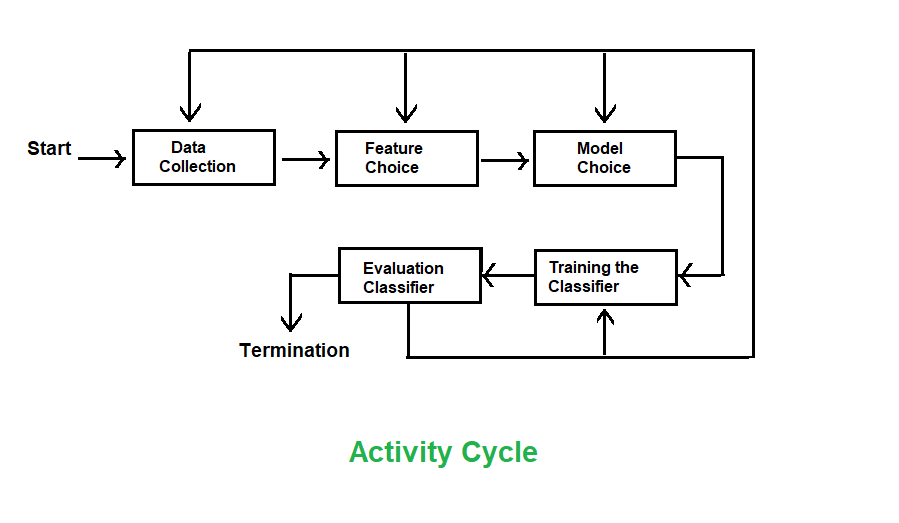Pattern Recognition – Phases and Activities
Last Updated :
08 Nov, 2023
Approaches for Pattern Recognition Systems can be represented by distinct phases, as Pattern Recognition Systems can be divided into the following components. In this article, we will cover the Phases and the Activities in the Pattern Recognition System. Let us begin with the Phases first.
Phases in Pattern Recognition System
- Phase 1: Convert images sounds or other inputs into signal data.
- Phase 2: Isolate the sensed objects from the background.
- Phase 3: Measure the object’s properties that are useful for classification.
- Phase 4: Assign the sensed object to a category.
- Phase 5: Take other considerations to decide on appropriate action.

Problems Solved by these Phases
- Sensing: It deals with problem arises in the input such as its bandwidth, resolution, sensitivity, distortion, signal-to-noise ratio, latency, etc.
- Segmentation and Grouping: Deepest problems in pattern recognition that deals with the problem of recognizing or grouping together the various parts of an object.
- Feature Extraction: It deals with the characterization of an object so that it can be recognized easily by measurements. Those objects whose values are very similar for the objects are considered to be in the same category, while those whose values are quite different for the objects are placed in different categories.
- Classification: It deals with assigning the object to their particular categories by using the feature vector provided by the feature extractor and determining the values of all of the features for a particular input.
- Post Processing: It deals with action decision-making by using the output of the classifier. Action such as minimum-error-rate classification will minimize the total expected cost.
Activities for Designing the Pattern Recognition Systems
There are various sequences of activities that are used for designing the Pattern Recognition Systems. These activities are as follows:
- Data Collection
- Feature Choice
- Model Choice
- Training
- Evaluation

- Data Collection: This is the initial step where you gather the data that you’ll use to train and test your pattern recognition system. The quality and quantity of data collected are crucial factors in the success of your system.
- Feature Choice: Features are the characteristics or attributes of the data that are relevant for pattern recognition. In this step, you decide which features or variables to use from your data. Feature selection is essential to reduce dimensionality and focus on the most informative aspects of your data.
- Model Choice: This step involves selecting the appropriate pattern recognition model or algorithm. The choice of model depends on the nature of the data and the problem at hand.
- Training: Once the model is chosen, it needs to be trained using a labeled dataset. During training, the model learns to identify patterns in the data and make predictions based on the features.
- Evaluation: After training, the performance of the pattern recognition system is assessed using a separate dataset that the model has not seen before. This evaluation dataset is used to measure the system’s ability to correctly recognize patterns and make predictions.
- There are typically four main phases in the pattern recognition process: preprocessing, training, testing, and deployment. These phases involve a series of activities that are designed to develop and evaluate a pattern recognition system.
- Preprocessing: Preprocessing is the process of preparing the data for analysis. This may involve cleaning the data, scaling the data, or transforming the data in some way to make it more suitable for analysis.
- Training: Training is the process of fitting a model to the data. This typically involves selecting a model, choosing appropriate hyperparameters, and optimizing the model’s parameters to minimize a loss function.
- Testing: Testing is the process of evaluating the performance of the model on a held-out dataset. This allows us to estimate the generalization performance of the model and to compare the performance of different models.
- Deployment: Deployment is the process of deploying the trained model in a production environment. This may involve integrating the model into an existing system or building a new system based on the model.
Python3
import numpy as np
def euclidean_distance(x, y):
return np.sqrt(np.sum((x - y) ** 2))
def find_nearest_neighbors(point, points, k=5):
distances = [euclidean_distance(point, p) for p in points]
nearest_neighbors = np.argsort(distances)[:k]
return nearest_neighbors
|
Share your thoughts in the comments
Please Login to comment...